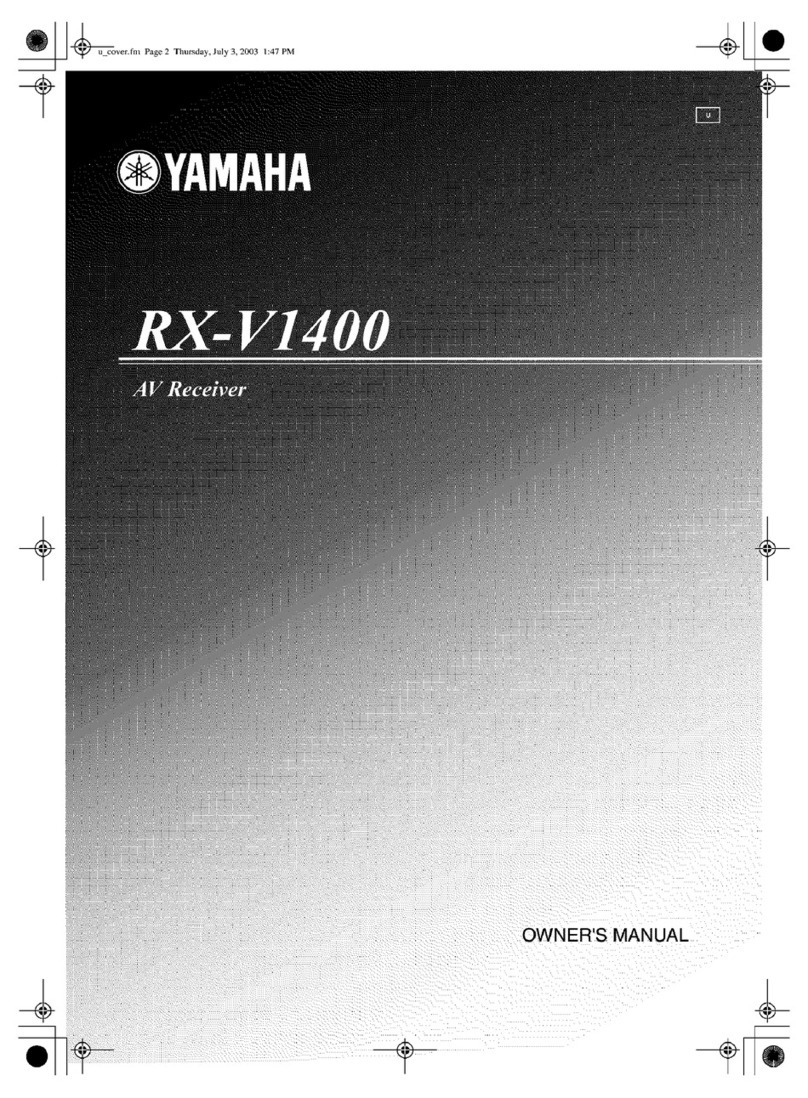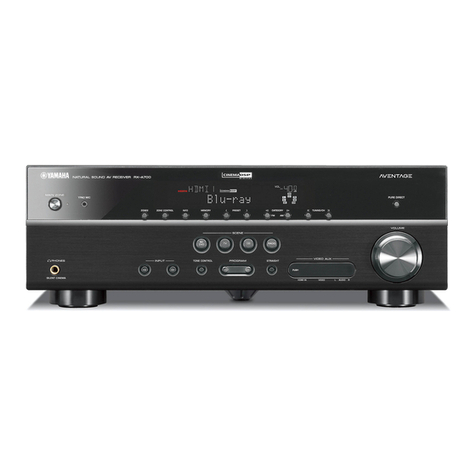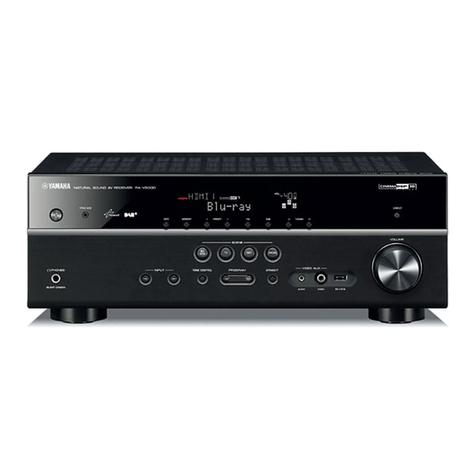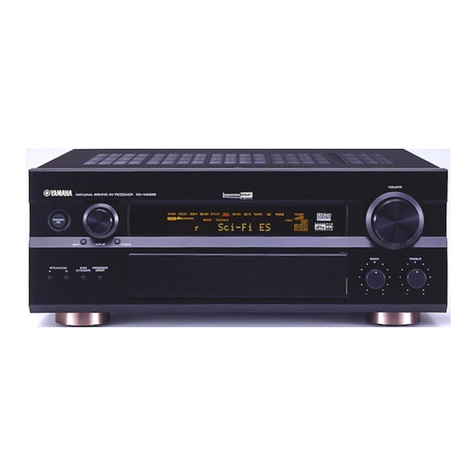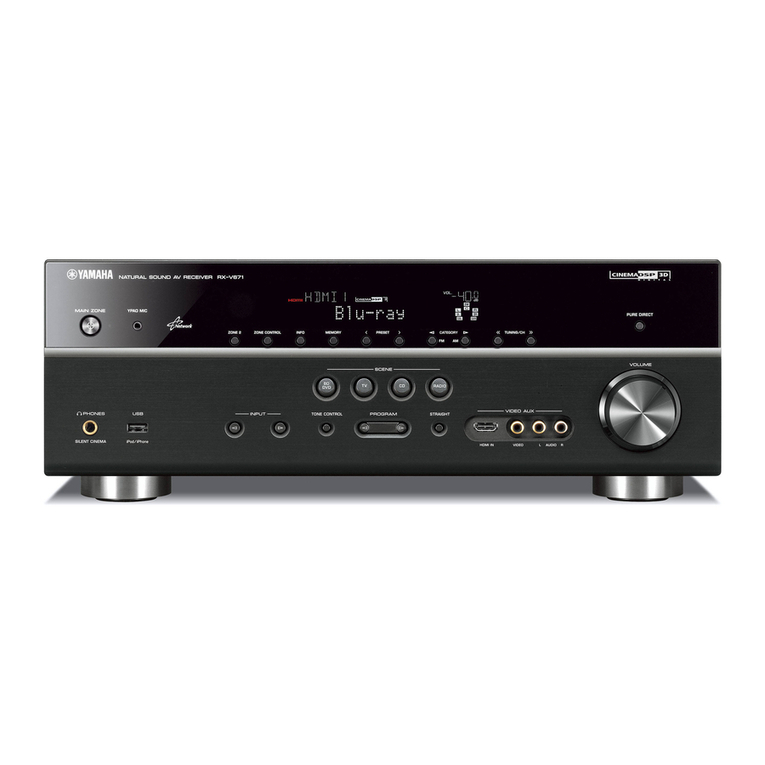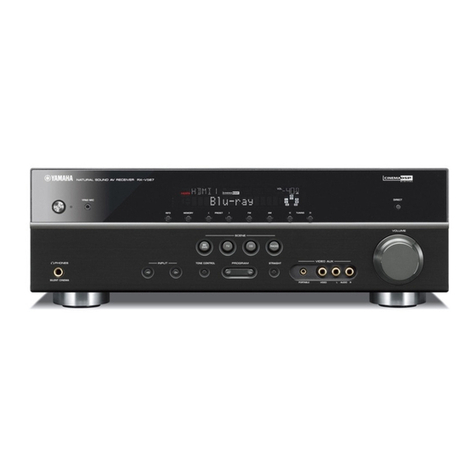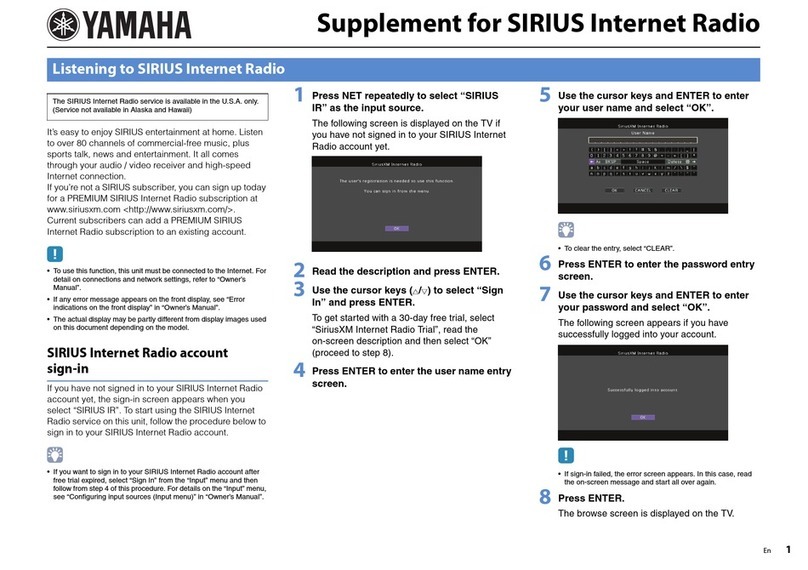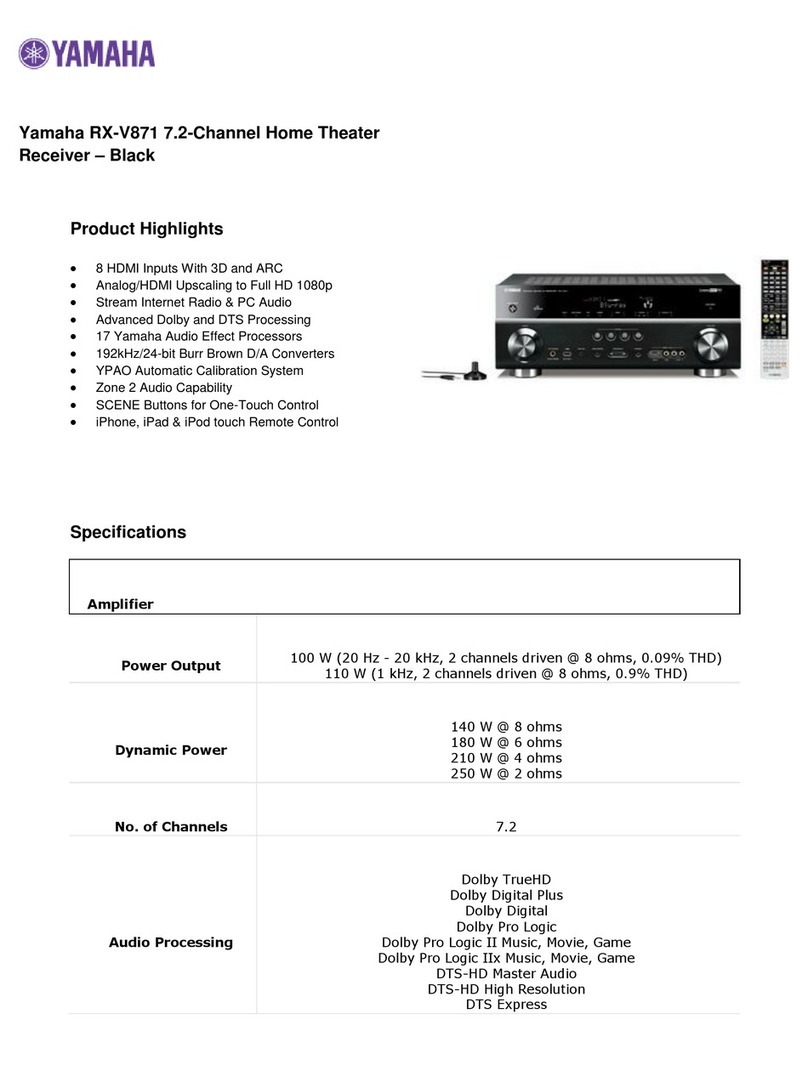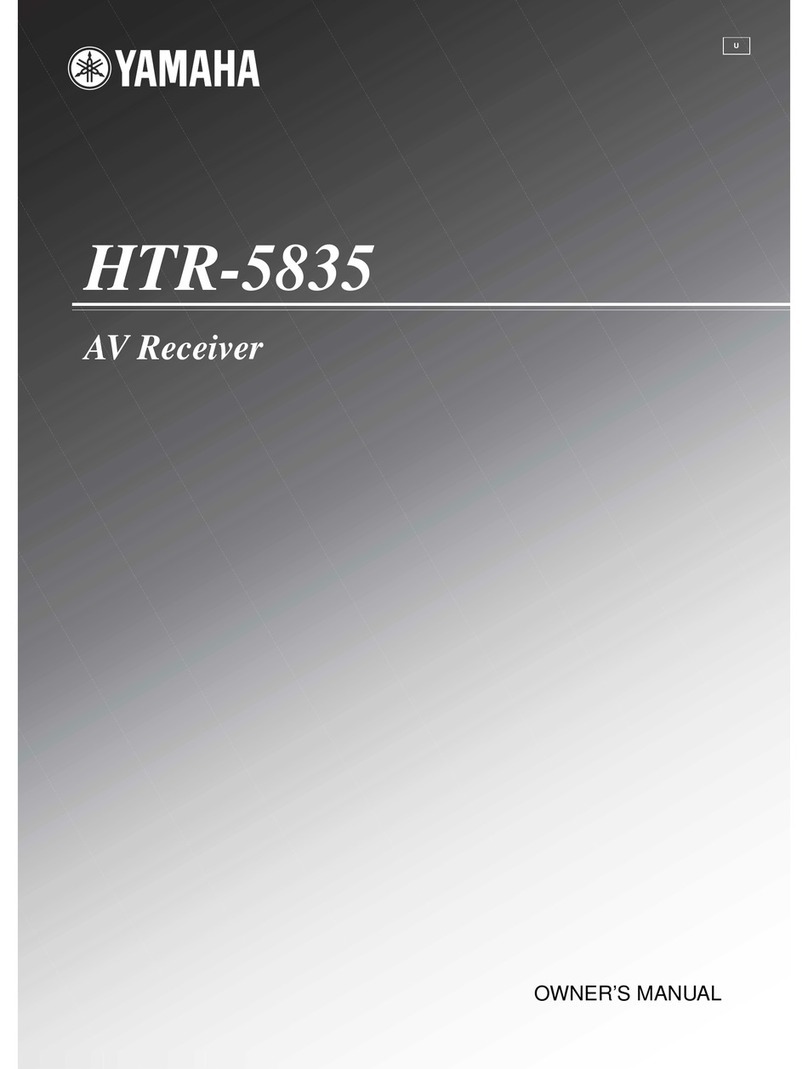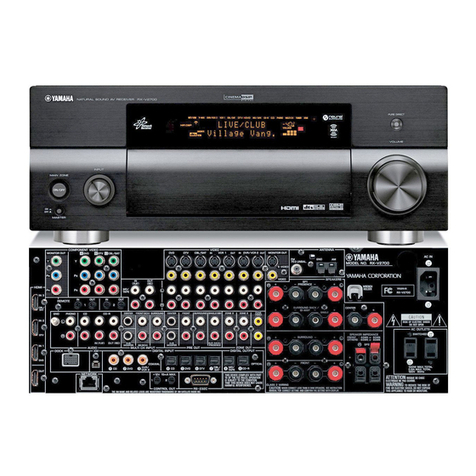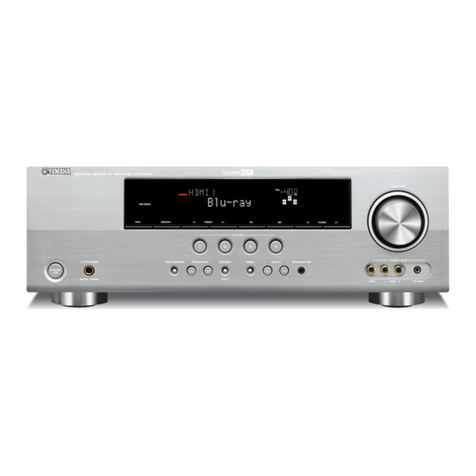
YAMAHA ELECTRONICS CORPORATION, USA 6660 ORANGETHORPE AVE., BUENA PARK, CALIF. 90620, U.S.A.
YAMAHA CANADA MUSIC LTD. 135 MILNER AVE., SCARBOROUGH, ONTARIO M1S 3R1, CANADA
YAMAHA ELECTRONIK EUROPA G.m.b.H. SIEMENSSTR. 22-34, 25462 RELLINGEN BEI HAMBURG, F.R. OF GERMANY
YAMAHA ELECTRONIQUE FRANCE S.A. RUE AMBROISE CROIZAT BP70 CROISSY-BEAUBOURG 77312 MARNE-LA-VALLEE CEDEX02, FRANCE
YAMAHA ELECTRONICS (UK) LTD. YAMAHA HOUSE, 200 RICKMANSWORTH ROAD WATFORD, HERTS WD1 7JS, ENGLAND
YAMAHA SCANDINAVIA A.B. J A WETTERGRENS GATA 1, BOX 30053, 400 43 VÄSTRA FRÖLUNDA, SWEDEN
YAMAHA MUSIC AUSTRALIA PTY, LTD. 17-33 MARKET ST., SOUTH MELBOURNE, 3205 VIC., AUSTRALIA
Printed in Malaysia V958260-2
GB
RX-V1300RDS
OWNER’S MANUAL
MODE D’EMPLOI
BEDIENUNGSANLEITUNG
BRUKSANVISNING
MANUALE DI ISTRUZIONI
MANUAL DE INSTRUCCIONES
GEBRUIKSAANWIJZING
AV Receiver
Ampli-Tuner Audio-Video
TECHNISCHE GEGEVENS
AUDIO GEDEELTE
• Minimum RMS uitgangsvermogen voor hoofd, midden, achter,
midden-achter
20 Hz t/m 20 kHz, 0,04 % THV, 8 Ohm ............................. 100 W
• Maximum uitgangsvermogen (EIAJ) [Modellen voor China en
algemene modellen]
1 kHz, 10 % THV, 8 Ohm ................................................... 150 W
• DIN Standaard uitgangsvermogen [Modellen voor Europa en
Groot-Brittannië]
1 kHz, 0,7 % THV, 4 Ohm .................................................. 145 W
• IEC uitgangsvermogen [Modellen voor Europa en Groot-
Brittannië]
1 kHz, 0,04 % THV, 8 Ohm ................................................ 115 W
• Dynamisch uitgangsvermogen (IHF)
8/6/4/2 Ohm .................................................... 140/170/205/245 W
• Dempingsfactor
20 Hz t/m 20 kHz, 8 Ohm ............................................ 80 of meer
• Frequentierespons
CD naar Hoofd L/R .............................. 10Hz t/m 100 kHz, –3 dB
• Totale Harmonische Vervorming
20 Hz t/m 20 kHz, 50 W, 8 Ohm, Hoofd L/R ...................... 0,04 %
• Signaal-ruis verhouding (IHF-A Netwerk)
PHONO MM (5 mV) naar Hoofd L/R ................................. 81 dB
CD (kortgesloten 250 mV) naar Hoofd L/R, Effect uit ...... 100 dB
• Residuele ruis (IHF-A Netwerk)
Hoofd L/R ......................................................... 150 µV of minder
• Kanaalscheiding (1 kHz/10 kHz)
CD (5,1 kOhm getermineerd) naar Hoofd L/R ......... 60 dB/45 dB
• Toonregeling (Hoofd L/R)
BASS versterking/verzwakking .............................. ±10 dB/50 Hz
TREBLE versterking/verzwakking ....................... ±10 dB/20 kHz
BASS EXTENSION .................................................. +6 dB/60 Hz
• Uitgangsvermogen hoofdtelefoon ........................ 150 mV/100 Ohm
• Ingangsgevoeligheid
PHONO .............................................................. 2,5 mV/47 kOhm
CD, etc ............................................................... 150 mV/47 kOhm
6CH INPUT ....................................................... 150 mV/47 kOhm
• Uitgangsniveau
REC OUT ......................................................... 150 mV/1,2 kOhm
PRE OUT ............................................................. 1,0 V/1,2 kOhm
SUBWOOFER ..................................................... 4,0 V/1,2 kOhm
VIDEO GEDEELTE
• Videosignaal-type ........................................................... NTSC/PAL
• Signaal-ruis verhouding .......................................................... 50 dB
• Frequentierespons (MONITOR OUT)
Composiet, S-Video ............................... 5 Hz t/m 10 MHz, –3 dB
Component ............................................... DC t/m 60 MHz, –3 dB
FM GEDEELTE
• Afstembereik
[Modellen voor de VS en Canada] ................ 87,5 t/m 107,9 MHz
[Overige modellen] .................................... 87,50 t/m 108,00 MHz
• Bruikbare gevoeligheid (IHF) .............................. 1,0 µV (11,2 dBf)
• Signaal-ruis verhouding (IHF)
Mono/Stereo .............................................................. 76 dB/70 dB
• Harmonische vervorming (1 kHz)
Mono/Stereo ............................................................... 0,2 %/0,3 %
• Stereoscheiding (1 kHz) .......................................................... 45 dB
• Frequentierespons ............................. 20 Hz t/m 15 kHz +0,5, –2 dB
AM GEDEELTE
• Afstembereik
[Modellen voor de VS en Canada] .................... 530 t/m 1710 kHz
[Modellen voor Europa, Groot-Brittannië en Australië]
........................................................................ 531 t/m 1611 kHz
[Overige modellen] ............................ 530/531 t/m 1710/1611 kHz
• Bruikbare gevoeligheid ..................................................... 300 µV/m
ALGEMEEN
• Stroomvoorziening
[Modellen voor de VS en Canada] ...... 120 V wisselstroom/60 Hz
[Modellen voor Europa en Groot-Brittannië]
.......................................................... 230 V wisselstroom/50 Hz
[Modellen voor Australië] ................... 240 V wisselstroom/50 Hz
[Modellen voor China] ........................ 220 V wisselstroom/50 Hz
[Algemene modellen] ..... 110/120/220/240 V wisselstroom, 50/60 Hz
• Stroomverbruik
[Modellen voor de VS en Canada] ......................... 400 W/500 VA
[Overige modellen] .............................................................. 410 W
Standby-stand .......................................................... 1 W of minder
• Netstroom-aansluitingen
[Modellen voor de VS en Canada] .. 2 (maximum totaal 80 W/0,8 A)
[Modellen voor Europa] ..................... 2 (maximum totaal 100 W)
[Modellen voor Groot-Brittannië en Australië]
......................................................... 1 (maximum totaal 100 W)
[Modellen voor China en algemene modellen]
........................................................... 2 (maximum totaal 50 W)
• Afmetingen (b x h x d) ..................................... 435 x 171 x 434 mm
• Gewicht ..................................................................................... 15 kg
RX-V1300RDS
0100V1300(GB)-cv1/4 2002.10.17, 11:441

